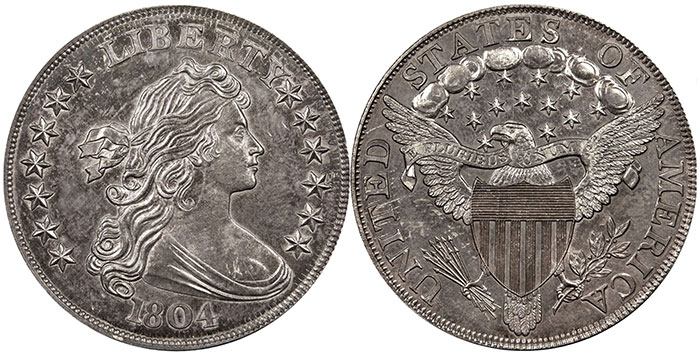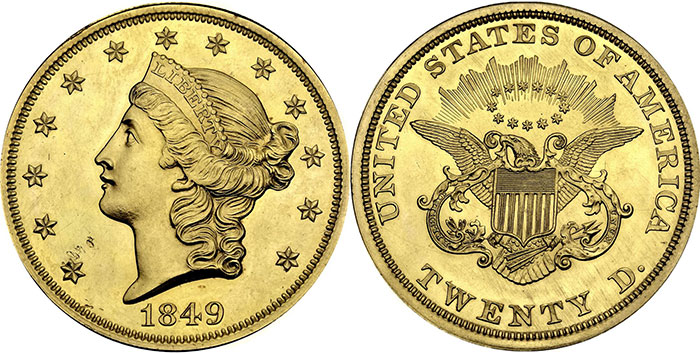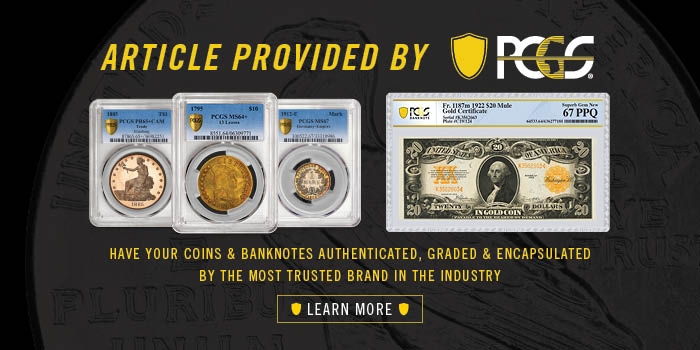![]()
By Joshua McMorrow-Hernandez for PCGS ……
As many numismatists know, several extremely rare United States coins are worth millions of dollars apiece and can ever only be owned by a tiny handful of collectors at any single time. These include famous trophy coins such as the 1913 Liberty nickel, the 1894-S Barber dime, and the 1804 Class I Draped Bust dollar. Even the iconic 1933 Saint Gaudens $20 double eagle, which is illegal to own, yields one specimen that was legally monetized by the U.S. government and presently resides in a private collection.
Yet, there is a small number of unique coins that are stowed away in public collections and museums, leaving them unavailable for private ownership. Which coins are they? Where can they be seen in person? Here’s a rundown of five of the most iconic unique coins you can’t own.
1866 No Motto Seated Liberty Quarter
Seated Liberty quarter enthusiasts spend years, even decades, seeking a few dates that are extremely rare and small in number. These include any of the early Proofs and the nearly elusive 1873-CC No Arrows, the latter of which has just five known specimens, each worth a six-figure sum.
Then there is the unique 1866 No Motto Seated Liberty quarter. It once resided in the cabinet of Egypt’s King Farouk before landing in the hands of Willis du Pont, who bought the coin in 1961 for the princely sum of $24,500.
Mr. du Pont, a descendant of the wealthy Delaware family whose name is synonymous with American industry, held the coin in his collection until one terrible evening in 1967 when his Miami home was burglarized. The thieves, robbing du Pont and his family at gunpoint, stole more than 7,000 coins, swiped a large collection of diamonds and jewels, and used du Pont’s red Cadillac as a getaway car. Over the years, many of the coins stolen from the collection, then valued at $1.5 million, have filtered back into the market. Among these are the 1866 No Motto Seated Liberty Quarter, a coin of unknown origin that was never recorded in the United States Mint Director’s Report.
The coin reappeared in 1999 at a Los Angeles coin shop more than 30 years after the rarity disappeared from the du Pont mansion nearly 3,000 miles away. The piece was soon returned to the family, and the 1866 No Motto quarter was eventually placed on loan to the American Numismatic Association (ANA) for display. In 2015, the coin was donated to the National Numismatic Collection of the Smithsonian Institution. And it is there that the coin is sure to remain for perpetuity.
1866 No Motto Seated Liberty Half Dollar
It’s no coincidence that the second coin to be listed in this article shares a very similar story to the first. That’s because the 1866 No Motto Seated Liberty half dollar, also a unique coin of unknown origin, was also owned by – and stolen from – Willis du Pont in the same armed 1967 heist that claimed the 1866 No Motto SLQ and thousands of his other collectible coins. And like its 1866 quarter counterpart, the 1866 No Motto half dollar turned up at a Los Angeles coin shop in 1999, some 32 years after the coin disappeared from the du Pont mansion.
The 1866 No Motto half dollar is one of those coins whose mysterious background has, like that of the coin’s quarter-dollar counterpart, long intrigued the numismatic community. Some believe that the 1866 half dollar may have been clandestinely struck in 1868 under the instruction of United States Mint Director Henry Linderman to present to 19th-century pattern collector Robert Coulton Davis. If the half dollar, the 1866 No Motto quarter, and the two known 1866 No Motto Liberty Seated dollars (one of which was also owned by du Pont) were truly struck under such dubious auspices, it has yet to be proven. But the mystique and incredible rarity of these coins are unquestionable.
The 1866 No Motto Seated Liberty half dollar was on display at the ANA for several years after its 1999 reappearance. However, the du Pont family eventually donated the coin, along with their 1866 No Motto quarter and 1866 No Motto Seated Liberty dollar, to the National Numismatic Collection of the Smithsonian Institution. This leaves no 1866 No Motto half dollars in private hands. However, one of the two known 1866 No Motto dollars is still theoretically available for collectors to vie for should it ever come to market.
1804 Class II Draped Bust Dollar

The 1804 Class II Draped Bust dollar? Indeed, there isn’t “the” 1804 dollar, but rather three types of 1804 dollars. Of the 15 total 1804 dollars known to exist, eight are original strikings produced circa 1834-1835; these are known as Class I dollars. Seven restrikes were made beginning around 1858, with one of these coins bearing a plain edge, known as the Class II piece; the remaining six restrikes with lettered edges are dubbed Class III specimens.
As with so many ultra-rarities, there are a plethora of unanswered questions surrounding the Class II dollar. It is believed that as the reverse of the Class II and Class III dollars are essentially identical, the edge lettering known on Class III dollars was actually applied after the coins were struck. This means that there may have essentially been more Class II dollars around today if not for the fact that the edge lettering was later stamped onto the edges of some of those originally plain-edge dollars. Interestingly, the only known Class II dollar was struck over a Swiss shooting thaler from 1857, a commemorative coin struck for a traditional shooting festival held in the canton of Bern.
The 1804 Class II Draped Bust dollar resides in the National Numismatic Collection at the Smithsonian Institution. Thus, the coin cannot be owned by private collectors. The value of such a unique coin is incalculable, but the other 1804 dollars have routinely traded for millions of dollars in recent years, implying that the elusive Class II dollar would also draw a seven-figure price, if not higher.
1870-S $3 Princess
The 1870-S $3 Princess is one of those coins that today’s collectors can’t own but a few once did. And, as with any great rare coin, there’s some degree of mystery behind this piece struck at the San Francisco Mint.
Numismatic experts can account for only one 1870-S Princess, but many believe a second was minted and is located within the cornerstone of the San Francisco Mint. The building, which was constructed in 1869 and served as a mint until 1937, is affectionately known as “The Granite Lady”. It was also one of the few buildings that survived the devastating 1906 earthquake that rocked San Francisco.

Even presuming that a second 1870-S Princess exists, locked away in a metal box within the massive walls of the Old Mint, the only example one can lay eyes upon is impounded at the ANA Money Museum in Colorado Springs, Colorado. That piece traded among some of the hobby’s most elite collectors before finding a home in the museum. The coin originally hailed from the collection of William H. Woodin, who served as the United States Secretary of the Treasury. When the piece was sold from his collection in 1911, it was accompanied by a note stating that 1870-S $3 Princess was a duplicate of the piece contained in the cornerstone of the San Francisco Mint.
The coin went through a series of hands, at one point even winding up in a jewelry mount. Then, in 1944, Arthur “Art” Kagin of Hollinbeck Coin Company listed the coin as a VF and offered it for $8,500 to Louis Eliasberg, the great 20th-century Baltimore numismatist who once built the most comprehensive United States coin collection then known. At that point, Eliasberg initially turned down the opportunity to own the unique coin, citing other pieces he was then focused on acquiring.
After turning down other offers to buy the coin, Eliasberg eventually did purchase the 1870-S $3 for $16,000, completing his collection of $3 Princesses. His monumental collection was offered for sale after Eliasberg’s passing in 1976. A few years later, in 1982, the Eliasberg 1870-S $3 Princess was sold to oil tycoon, philanthropist, and coin collector Harry W. Bass, Jr. for $687,500 and later became a centerpiece rarity at the Money Museum. And while nobody has the chance to buy the coin, everyone has the opportunity to view it.
1849 Liberty Head $20 Double Eagle
The fifth coin on this list of rarities that you can’t own is the 1849 Liberty Head $20 double eagle. It’s a piece that even Louis Eliasberg had to bypass. The coin, technically classified as a pattern, ushered in the first federal United States coin of a higher denomination than $10.
The unique 1849 Liberty Head double eagle has been theorized by many to be the most valuable United States coin ever struck. Some years back, rare coin dealer Kevin Lipton pegged the value of the 1849 $20 Liberty Head piece as being somewhere between $10 million and $20 million. To be sure, such talk is nothing more than hypothetical, as the 1849 double eagle safely resides in the National Numismatic Collection of the Smithsonian and is not for sale.
Still, if the 1849 Liberty Head $20 double eagle were to sell and did so for only a middle-ground figure based on Lipton’s estimate–say, $15 million–it would still easily eclipse the price of the most expensive coin ever sold to date. That claim goes to a PCGS-certified 1794 Flowing Hair dollar grading SP66, which realized $10,016,875 at a 2013 Stack’s Bowers auction.





